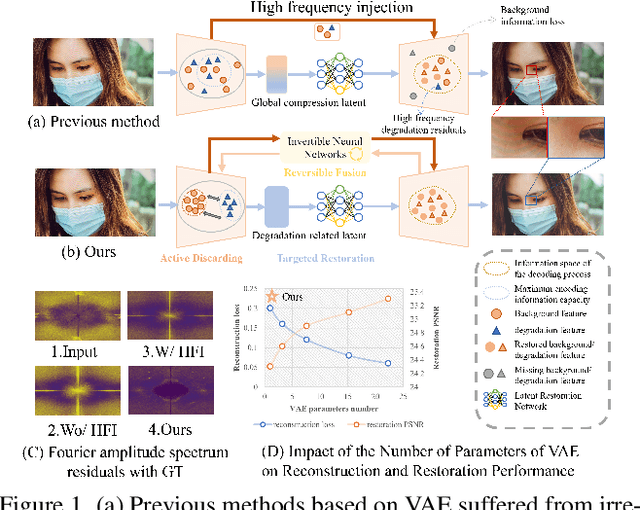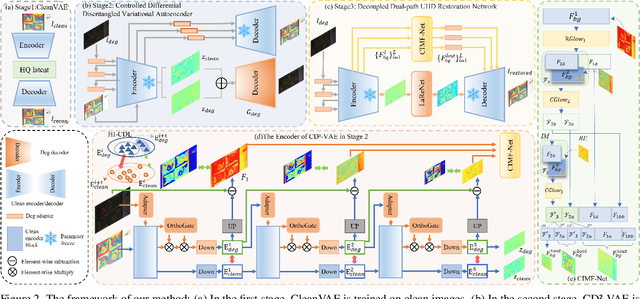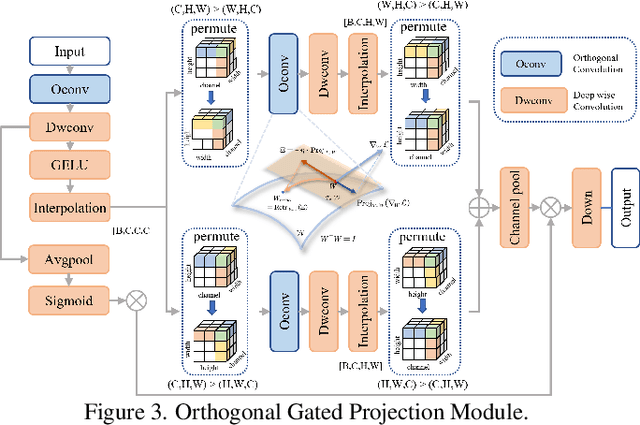Xueyang Fu
Latent Harmony: Synergistic Unified UHD Image Restoration via Latent Space Regularization and Controllable Refinement
Oct 09, 2025



Abstract:Ultra-High Definition (UHD) image restoration faces a trade-off between computational efficiency and high-frequency detail retention. While Variational Autoencoders (VAEs) improve efficiency via latent-space processing, their Gaussian constraint often discards degradation-specific high-frequency information, hurting reconstruction fidelity. To overcome this, we propose Latent Harmony, a two-stage framework that redefines VAEs for UHD restoration by jointly regularizing the latent space and enforcing high-frequency-aware reconstruction.In Stage One, we introduce LH-VAE, which enhances semantic robustness through visual semantic constraints and progressive degradation perturbations, while latent equivariance strengthens high-frequency reconstruction.Stage Two jointly trains this refined VAE with a restoration model using High-Frequency Low-Rank Adaptation (HF-LoRA): an encoder LoRA guided by a fidelity-oriented high-frequency alignment loss to recover authentic details, and a decoder LoRA driven by a perception-oriented loss to synthesize realistic textures. Both LoRA modules are trained via alternating optimization with selective gradient propagation to preserve the pretrained latent structure.At inference, a tunable parameter {\alpha} enables flexible fidelity-perception trade-offs.Experiments show Latent Harmony achieves state-of-the-art performance across UHD and standard-resolution tasks, effectively balancing efficiency, perceptual quality, and reconstruction accuracy.
Fractional Spike Differential Equations Neural Network with Efficient Adjoint Parameters Training
Jul 22, 2025Abstract:Spiking Neural Networks (SNNs) draw inspiration from biological neurons to create realistic models for brain-like computation, demonstrating effectiveness in processing temporal information with energy efficiency and biological realism. Most existing SNNs assume a single time constant for neuronal membrane voltage dynamics, modeled by first-order ordinary differential equations (ODEs) with Markovian characteristics. Consequently, the voltage state at any time depends solely on its immediate past value, potentially limiting network expressiveness. Real neurons, however, exhibit complex dynamics influenced by long-term correlations and fractal dendritic structures, suggesting non-Markovian behavior. Motivated by this, we propose the Fractional SPIKE Differential Equation neural network (fspikeDE), which captures long-term dependencies in membrane voltage and spike trains through fractional-order dynamics. These fractional dynamics enable more expressive temporal patterns beyond the capability of integer-order models. For efficient training of fspikeDE, we introduce a gradient descent algorithm that optimizes parameters by solving an augmented fractional-order ODE (FDE) backward in time using adjoint sensitivity methods. Extensive experiments on diverse image and graph datasets demonstrate that fspikeDE consistently outperforms traditional SNNs, achieving superior accuracy, comparable energy efficiency, reduced training memory usage, and enhanced robustness against noise. Our approach provides a novel open-sourced computational toolbox for fractional-order SNNs, widely applicable to various real-world tasks.
NTIRE 2025 Image Shadow Removal Challenge Report
Jun 18, 2025Abstract:This work examines the findings of the NTIRE 2025 Shadow Removal Challenge. A total of 306 participants have registered, with 17 teams successfully submitting their solutions during the final evaluation phase. Following the last two editions, this challenge had two evaluation tracks: one focusing on reconstruction fidelity and the other on visual perception through a user study. Both tracks were evaluated with images from the WSRD+ dataset, simulating interactions between self- and cast-shadows with a large number of diverse objects, textures, and materials.
NTIRE 2025 Challenge on Event-Based Image Deblurring: Methods and Results
Apr 16, 2025Abstract:This paper presents an overview of NTIRE 2025 the First Challenge on Event-Based Image Deblurring, detailing the proposed methodologies and corresponding results. The primary goal of the challenge is to design an event-based method that achieves high-quality image deblurring, with performance quantitatively assessed using Peak Signal-to-Noise Ratio (PSNR). Notably, there are no restrictions on computational complexity or model size. The task focuses on leveraging both events and images as inputs for single-image deblurring. A total of 199 participants registered, among whom 15 teams successfully submitted valid results, offering valuable insights into the current state of event-based image deblurring. We anticipate that this challenge will drive further advancements in event-based vision research.
EventMamba: Enhancing Spatio-Temporal Locality with State Space Models for Event-Based Video Reconstruction
Mar 27, 2025Abstract:Leveraging its robust linear global modeling capability, Mamba has notably excelled in computer vision. Despite its success, existing Mamba-based vision models have overlooked the nuances of event-driven tasks, especially in video reconstruction. Event-based video reconstruction (EBVR) demands spatial translation invariance and close attention to local event relationships in the spatio-temporal domain. Unfortunately, conventional Mamba algorithms apply static window partitions and standard reshape scanning methods, leading to significant losses in local connectivity. To overcome these limitations, we introduce EventMamba--a specialized model designed for EBVR tasks. EventMamba innovates by incorporating random window offset (RWO) in the spatial domain, moving away from the restrictive fixed partitioning. Additionally, it features a new consistent traversal serialization approach in the spatio-temporal domain, which maintains the proximity of adjacent events both spatially and temporally. These enhancements enable EventMamba to retain Mamba's robust modeling capabilities while significantly preserving the spatio-temporal locality of event data. Comprehensive testing on multiple datasets shows that EventMamba markedly enhances video reconstruction, drastically improving computation speed while delivering superior visual quality compared to Transformer-based methods.
Decouple to Reconstruct: High Quality UHD Restoration via Active Feature Disentanglement and Reversible Fusion
Mar 17, 2025



Abstract:Ultra-high-definition (UHD) image restoration often faces computational bottlenecks and information loss due to its extremely high resolution. Existing studies based on Variational Autoencoders (VAE) improve efficiency by transferring the image restoration process from pixel space to latent space. However, degraded components are inherently coupled with background elements in degraded images, both information loss during compression and information gain during compensation remain uncontrollable. These lead to restored images often exhibiting image detail loss and incomplete degradation removal. To address this issue, we propose a Controlled Differential Disentangled VAE, which utilizes Hierarchical Contrastive Disentanglement Learning and an Orthogonal Gated Projection Module to guide the VAE to actively discard easily recoverable background information while encoding more difficult-to-recover degraded information into the latent space. Additionally, we design a Complex Invertible Multiscale Fusion Network to handle background features, ensuring their consistency, and utilize a latent space restoration network to transform the degraded latent features, leading to more accurate restoration results. Extensive experimental results demonstrate that our method effectively alleviates the information loss problem in VAE models while ensuring computational efficiency, significantly improving the quality of UHD image restoration, and achieves state-of-the-art results in six UHD restoration tasks with only 1M parameters.
Directing Mamba to Complex Textures: An Efficient Texture-Aware State Space Model for Image Restoration
Jan 27, 2025



Abstract:Image restoration aims to recover details and enhance contrast in degraded images. With the growing demand for high-quality imaging (\textit{e.g.}, 4K and 8K), achieving a balance between restoration quality and computational efficiency has become increasingly critical. Existing methods, primarily based on CNNs, Transformers, or their hybrid approaches, apply uniform deep representation extraction across the image. However, these methods often struggle to effectively model long-range dependencies and largely overlook the spatial characteristics of image degradation (regions with richer textures tend to suffer more severe damage), making it hard to achieve the best trade-off between restoration quality and efficiency. To address these issues, we propose a novel texture-aware image restoration method, TAMambaIR, which simultaneously perceives image textures and achieves a trade-off between performance and efficiency. Specifically, we introduce a novel Texture-Aware State Space Model, which enhances texture awareness and improves efficiency by modulating the transition matrix of the state-space equation and focusing on regions with complex textures. Additionally, we design a {Multi-Directional Perception Block} to improve multi-directional receptive fields while maintaining low computational overhead. Extensive experiments on benchmarks for image super-resolution, deraining, and low-light image enhancement demonstrate that TAMambaIR achieves state-of-the-art performance with significantly improved efficiency, establishing it as a robust and efficient framework for image restoration.
DemosaicFormer: Coarse-to-Fine Demosaicing Network for HybridEVS Camera
Jun 12, 2024



Abstract:Hybrid Event-Based Vision Sensor (HybridEVS) is a novel sensor integrating traditional frame-based and event-based sensors, offering substantial benefits for applications requiring low-light, high dynamic range, and low-latency environments, such as smartphones and wearable devices. Despite its potential, the lack of Image signal processing (ISP) pipeline specifically designed for HybridEVS poses a significant challenge. To address this challenge, in this study, we propose a coarse-to-fine framework named DemosaicFormer which comprises coarse demosaicing and pixel correction. Coarse demosaicing network is designed to produce a preliminary high-quality estimate of the RGB image from the HybridEVS raw data while the pixel correction network enhances the performance of image restoration and mitigates the impact of defective pixels. Our key innovation is the design of a Multi-Scale Gating Module (MSGM) applying the integration of cross-scale features, which allows feature information to flow between different scales. Additionally, the adoption of progressive training and data augmentation strategies further improves model's robustness and effectiveness. Experimental results show superior performance against the existing methods both qualitatively and visually, and our DemosaicFormer achieves the best performance in terms of all the evaluation metrics in the MIPI 2024 challenge on Demosaic for Hybridevs Camera. The code is available at https://github.com/QUEAHREN/DemosaicFormer.
Towards Realistic Data Generation for Real-World Super-Resolution
Jun 12, 2024



Abstract:Existing image super-resolution (SR) techniques often fail to generalize effectively in complex real-world settings due to the significant divergence between training data and practical scenarios. To address this challenge, previous efforts have either manually simulated intricate physical-based degradations or utilized learning-based techniques, yet these approaches remain inadequate for producing large-scale, realistic, and diverse data simultaneously. In this paper, we introduce a novel Realistic Decoupled Data Generator (RealDGen), an unsupervised learning data generation framework designed for real-world super-resolution. We meticulously develop content and degradation extraction strategies, which are integrated into a novel content-degradation decoupled diffusion model to create realistic low-resolution images from unpaired real LR and HR images. Extensive experiments demonstrate that RealDGen excels in generating large-scale, high-quality paired data that mirrors real-world degradations, significantly advancing the performance of popular SR models on various real-world benchmarks.
FourierMamba: Fourier Learning Integration with State Space Models for Image Deraining
May 29, 2024



Abstract:Image deraining aims to remove rain streaks from rainy images and restore clear backgrounds. Currently, some research that employs the Fourier transform has proved to be effective for image deraining, due to it acting as an effective frequency prior for capturing rain streaks. However, despite there exists dependency of low frequency and high frequency in images, these Fourier-based methods rarely exploit the correlation of different frequencies for conjuncting their learning procedures, limiting the full utilization of frequency information for image deraining. Alternatively, the recently emerged Mamba technique depicts its effectiveness and efficiency for modeling correlation in various domains (e.g., spatial, temporal), and we argue that introducing Mamba into its unexplored Fourier spaces to correlate different frequencies would help improve image deraining. This motivates us to propose a new framework termed FourierMamba, which performs image deraining with Mamba in the Fourier space. Owning to the unique arrangement of frequency orders in Fourier space, the core of FourierMamba lies in the scanning encoding of different frequencies, where the low-high frequency order formats exhibit differently in the spatial dimension (unarranged in axis) and channel dimension (arranged in axis). Therefore, we design FourierMamba that correlates Fourier space information in the spatial and channel dimensions with distinct designs. Specifically, in the spatial dimension Fourier space, we introduce the zigzag coding to scan the frequencies to rearrange the orders from low to high frequencies, thereby orderly correlating the connections between frequencies; in the channel dimension Fourier space with arranged orders of frequencies in axis, we can directly use Mamba to perform frequency correlation and improve the channel information representation.
 Add to Chrome
Add to Chrome Add to Firefox
Add to Firefox Add to Edge
Add to Edge